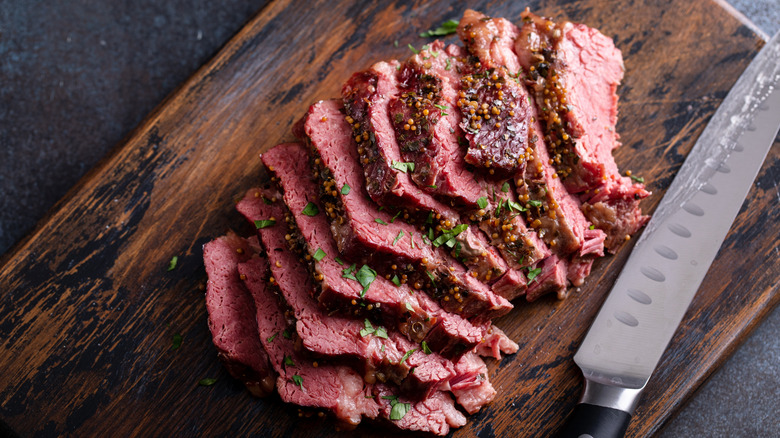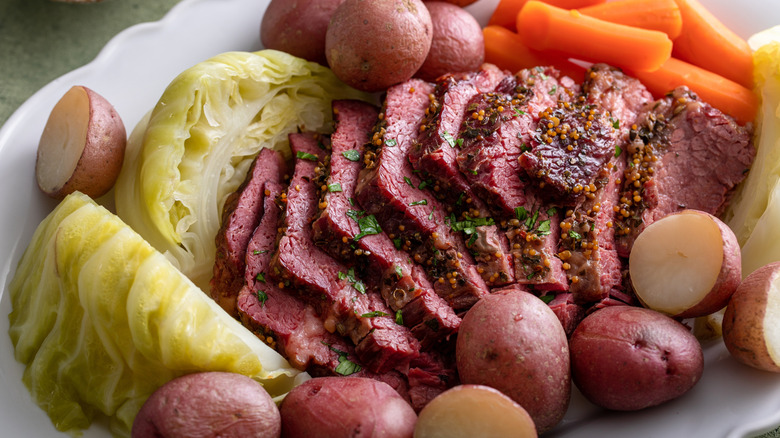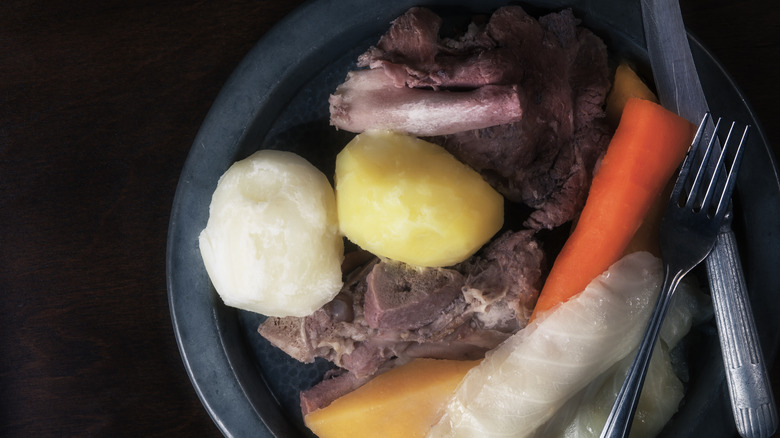Is There A Difference Between Corned Beef & Salt Beef?
The terms "corned beef" and "salt beef" are quite often used as if they mean the same thing, especially in different parts of the world. While they share a common denominator in the age-old practice of salt-curing meat, there are a few differences that affect their flavor and how they're used in cooking like many other well-known cured meats.
Before refrigeration, preserving meat was a matter of survival where salt played a starring role, drawing out moisture and preventing the growth of bacteria that would spoil it. This basic principle is at the heart of both corned beef and salt beef. Both usually start with beef brisket, a tough cut of meat that benefits from the long, slow curing process, as it tenderizes and becomes more flavorful.
In America, the words are frequently thrown around together, when in actuality, the corned beef referred to is actually salt beef. In other countries, there's hardly any distinction, but beneath the cooked surface, subtle yet significant differences can be found.
Corned beef is served with a blend of spices and is ready for celebration
Corned beef gets its name from the corns, or large grains, of salt that were originally used in the curing process. It's beef brisket that's been cured in a brine that also includes a blend of spices and sometimes a little bit of sugar. The spice mix usually includes mustard and coriander seeds, peppercorns, cloves, and bay leaves. This combination of spices gives corned beef its tangy and savory flavor that is known and loved.
In the United States, corned beef is mostly associated with St. Patrick's Day, often served as the featured meal with cabbage and potatoes. This tradition reflects the history of Irish-American immigrants, who adopted corned beef as a more affordable alternative to bacon. Many supermarkets even sell pre-cooked corned beef, making it a convenient option for a quick meal for the holiday. While corned beef has historical links to Ireland, the Irish don't actually eat corned beef on St. Patrick's Day. While corned beef and cabbage is typically the main course in America, it can also be sliced for sandwiches, or used in an easy corned beef hash recipe.
The lesser seasoned but still delicious salt beef
Salt beef, sticking true to its name, focuses on the salt. It's beef cured with salt, and typically without the mix of spices found in corned beef. As such, salt beef has a more straightforward, salty flavor that focuses on the taste of the beef itself. While brisket is the most common cut used, other cuts, like silverside or even tongue, can also be turned into salt beef. Since salt beef doesn't have the added spices and is more beef-centric, it makes a great addition to meals that have stronger flavors. It makes for a good choice in sandwiches like a salt beef slider, salads, or even a lasagna.
In some parts of the world like Canada, salt beef is a regional specialty. It's a key part in Jiggs Dinner, which is a traditional Sunday meal that also includes vegetables and pease pudding (boiled split peas). In other parts of the globe, like the United Kingdom, salt beef and corned beef are the same — both are made with spices and salt — but corned beef is minced and canned while salt beef is left whole. Since salt beef and corned beef come from the same cut, you can usually substitute one for the other, depending on your preference and seasonings used.



